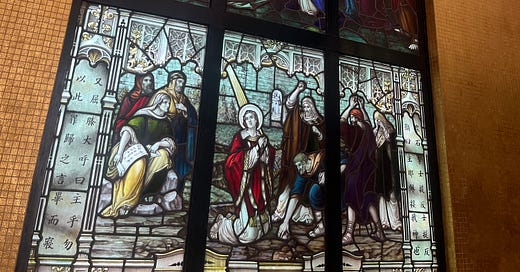Hello, friends. Thank you for your kind and wonderful birthday messages. It was a lovely birthday, or should I say birth week as the celebrations continue. I wanted to finish my series on my travels in Asia, so for this week, I give you pictures, and slightly disjointed memories and impressions of a place I have come to love: Hong Kong.
The Reverend Canon Ip, vicar of St Stephen’s Church on Hong Kong Island, is discussing the history of the elevation of the eucharist during the consecration. In medieval times, he says, there were no microphones, so the people in the back of the church couldn’t tell what was happening during most of the service. But when the priest raised the host over the congregation (Canon Ip illustrates with hand-gestures) people knew the most important moment had come: there was Christ’s body and blood. Someone asks, then, if the reason for the elevation was practical (so people could see) or theological (acknowledging the importance of what was happening). I only pick up bits of the answer, as the table beings to slips in an out of Cantonese. One man shakes his head with a smile, remarking on the low church habits of the church in Bristol that he’s joined since moving to the UK.
This lunch takes place at a Beijing/Peking style restaurant after a church service at St Stephen’s Anglican Church, the oldest Chinese speaking church in Hong Kong. And, I’m told by several people, the first church in Asia to have air conditioning. This is no small appeal to churchgoers in Hong Kong where the temperatures were reaching above 30 degrees celsius (around 90 degrees Fahrenheit) in early May. The liturgy that morning was sung in Cantonese to the 15th century Merbecke setting of the Book of Common Prayer, the same tune that my church used for many years. So while everyone else sings the Gloria, the Angus Dei, and the creed in Cantonese, I sing under my breath in English, completely aware of what is happening because of the shared liturgy. In the lobby of the church, I see something else surprisingly familiar. When I first came to this church several years ago, I remarked that the stained glass above looked like it belonged to the 19th century arts and crafts movement. Imagine my surprise (and smugness) upon discovering the signature in the corner of the glass: William Morris & Company. It is such a unique and mysterious work of art, especially with the inclusion of Classical Chinese. I determine to learn more.
Keep reading with a 7-day free trial
Subscribe to Joy Clarkson to keep reading this post and get 7 days of free access to the full post archives.





